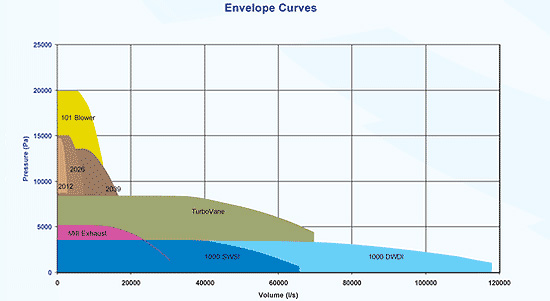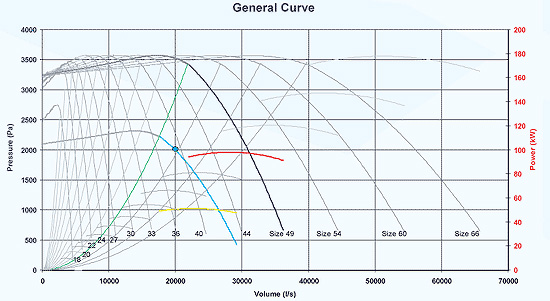Selection Guidelines
Envelope Curves
The following graph shows the volume – pressure envelope curves for the various series of fans offered in this product guide. It can act as a guide to match the required duty with the appropriate fan series. Only the single stage performance characteristics are shown.

For duties outside the envelopes shown contact FBA.
The envelope curves for the Series 3000 Blowers have not been included, as they closely approximate those drawn for the 2000 Series. Similarly, the envelope curve for the in-line Series approximates that identified for the Series 1000 SWSI fans.
Temperature Effects
Fan and Blower standard Arrangement 1 Centrifugal fans will handle air up to a temperature of 120°C. With the addition of heat slingers, separate motor bases, insulated housings and bearing modifications, temperatures of 400°C can be handled. Fans can be constructed to suit applicatons in excess of 400°C with further modification.
The selection data for FBA fans has been determined for standard air: 1.2 kg/m3 or 20°C at sea level.
As well as changes to the fan construction, the selection data also requires modification when handling gases at differing densities.
A fan can be considered as a constant volume machine. The volume of the gas delivered does not change with a change in gas density.
Factors must be applied however to the pressure and absorbed power. Additional information is contained within the selection program or from FBA.
Fan Performance Curves
The following is an example of the fan curves represented in this product guide. For each fan in a series, the volume – pressure envelope curve with the corresponding power curve has been shown on a single graph. This graph shows the pressure limits of our standard single stage fans and blowers for our common fan sizes.
Although they can be belt driven, the high pressure blowers, Series 2000, Series 3000 and Series 101, are usually supplied arrangement 4 – directly driven. The performance graph for these fans have therefore been formulated at 2900 rpm. For the other fan series, the performance graphs have been formulated with a limit of 2900 rpm and a limiting tip speed. By using a belt driven fan the desired performance requirements within the envelope curve can be exactly matched at a reduced speed.
The volume – pressure curve, represented in blue, has two sections. The solid portion is the preferred operation area and is referred to as the stable side of the curve. For the Series 2000, Series 3000 and Series 101 Blower, the entire curve can be used, however another fan selection may offer a more efficient solution.
For our other range of fans, a green system curve has been included that shows the limit of stable operation for that particular fan size. Care must be taken to ensure that fans are selected to the right of this system curve.
A power curve, represented in red, has been formulated for the stable portion of each fan.
Example: Assume a duty of 20000 l/s and 2000 Pa. This duty is denoted by cyan coloured dot.
A stable selection is to the right of the system curve. By following the first green system curve to the left of the duty point to its intersection point with the pressure curve, we can determine that the largest and probably the most quiet fan for this duty is a size 49. The actual fan curve has been shown with the corresponding power curve for the fan operating at the reduced speed.
A true comparison between this fan and the next smaller fan can be determined by examining the detailed information from the selection program.

Terms and Conditions | Privacy Policy
© 2020 Fan & Blower Australia


